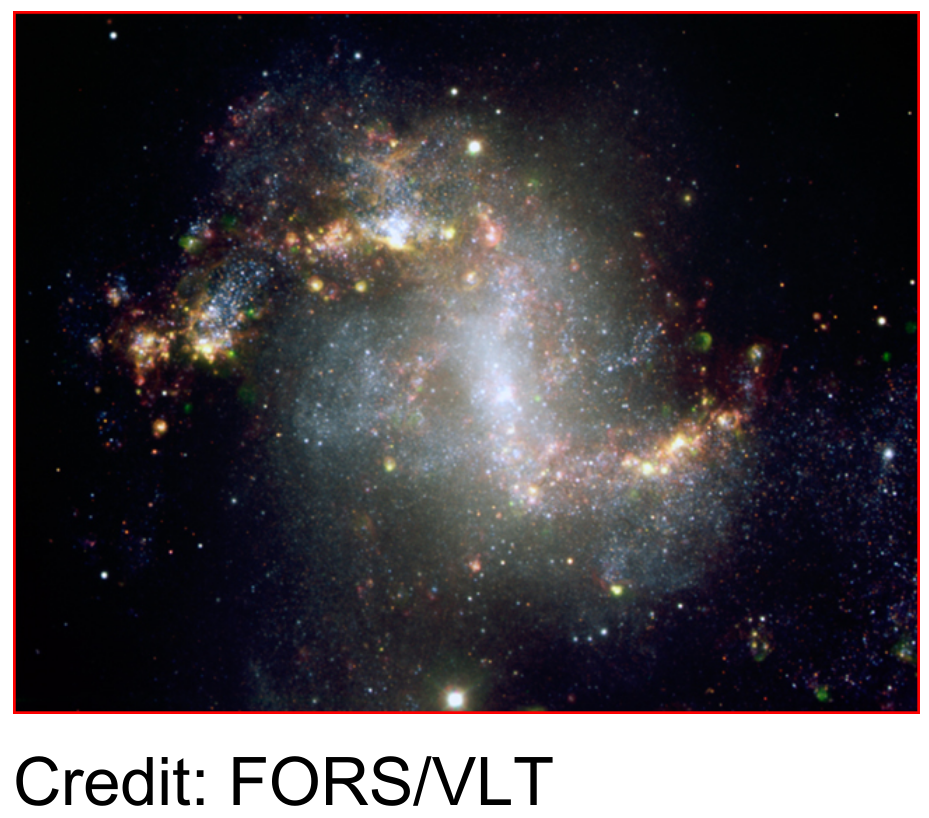[Unsolved Mysteries of a “Starburst” Galaxy 「スターバースト」銀河の未解決ミステリー]

The “starburst” galaxy NGC 1313. Image taken with the FORS instrument at ESO's Very Large Telescope.
「スターバースト」銀河NGC1313。ESOの超大型望遠鏡でFORS装置を使用して撮影された画像。
――――――――
Dec 11, 2006
NGC 1313、大マゼラン雲の近くの南天にある棒状渦巻銀河は、標準的な宇宙論を混乱させますが、電気的宇宙に準拠する5つの特徴を表示します。
上に示した銀河の最も明白な特徴は、腕の周りの明るい恒星形成領域のリングと、腕の歪んだ、引き裂かれた構造です。
銀河を歪め、恒星達の出現につながるガス雲の重力崩縮を開始するために標準理論で利用できる唯一のメカニズムは、別の銀河との衝突です。
特に腕の中に恒星形成の輪がある場合、衝突する銀河は、小石が池に落ちたように、ターゲットの銀河のガスに「圧力波」を生成するために、「ディスクを直接通過する」必要があります。
〈https://hubblesite.org/hubble-30th-anniversary/hubbles-exciting-universe/surveying-the-solar-system〉
物質の塊が小さく、それらの分離が大きい宇宙では、そのような直接的な打撃(衝突)に対する確率は天文学的なものです。
しかし、NGC 1313では、ニアミスでさえ不可能です:
それは孤立しています。
1,500万光年離れたその近くには、他の銀河はありません。
別の銀河がそれと融合したという兆候は(その歪んだ腕と恒星形成の輪を除いて)明らかではありません。
南東の近くに現れる小さくてはるかに暗い銀河がありますが、それは標準的な[赤方偏移-距離]の法則に従って、それが16倍離れていることを示す赤方偏移を持っています。
次に、同じ方向にクエーサーがあり、線に沿ってそれほど遠くはありませんが、もちろん、標準的な仮定の下では、宇宙の端に向かってはるかに遠くにあります。
NGC 1313から同じ南東の線に沿って少し離れたところに、2つのかすかな銀河がありますが、やはり赤方偏移が大きいため、10億光年以上離れています。
そして、もう少し遠くにあるのは、NGC1313を超えて最初のかすかな銀河とほぼ同じ距離にある別の銀河です。
NGC 1313の反対方向、北西には、さらに2つのクエーサーがあります。
これらと南東にあるものは、銀河の基準内にある唯一のクエーサーです。
それらが存在するその線は、NGC1313のスピン軸の延長です。
これらの7つのオブジェクトは、赤方偏移が測定されたこの付近の唯一のオブジェクトです。
しかし、視覚的には、NGC1313の範囲内に100を超える銀河があります。
それらがNGC1313の可能性のある隣人になることを妨げる唯一の考慮事項は、小さくてかすかな外観は遠く離れていることを意味するという標準的な仮定です。
これらのページの読者は、NGC 1313を通って伸びる高赤方偏移のオブジェクトの線が、ハルトン・アープと彼の同僚達が30年以上にわたって記録したアクティブな銀河からの放出のパターンに対応していることを認識するでしょう。
〈https://takaakifukatsu.hatenablog.jp/entry/2021/06/08/214127〉
原則として、クエーサーは、アクティブな中央銀河よりも一貫して高い赤方偏移を持つコンパニオン銀河とともに、アクティブな銀河のスピン軸に沿って分布しています。
歪んだ腕とこのような大きな恒星形成領域を持つ特に活発な銀河は、新しいクエーサーを生成する過程にありがちです。
クエーサーの特徴の1つは、強力なX線放射であり、NGC 1313の範囲内で、2つの物体が超大光度X線(ULX)源として識別されています。
超大光度X線(ULX)はホスト銀河内にあるように見えるため、標準的な理論ではクエーサーとして識別できません:
クエーサーの高い赤方偏移は、それらが遠く離れていることを必要とします。
多くの超大光度X線(ULX)が綿密に調査され、クエーサーであることが判明しました―
それはその後、前景銀河の「穴」を通して見た「背景オブジェクト」として却下されました。
ほとんどの超大光度X線(ULX)は、ホスト銀河によって最近生成されたクエーサーであることが判明する可能性があります。
電気的宇宙モデルと標準モデルの根本的な違いは、電気的宇宙モデルがガスではなく、宇宙の99%以上を構成するプラズマに基づいていることです。
〈https://takaakifukatsu.hatenablog.jp/entry/2021/06/23/203318〉
プラズマは主に電磁気学の法則に従います;
重力とガスのダイナミクスの考慮は補助的です;
天体の形や振る舞い、そしてそれらの相互作用は、主に電気回路の観点から理解されています。
〈https://takaakifukatsu.hatenablog.jp/entry/2021/06/09/081019〉
電気的宇宙モデルでは、NGC 1313のすべての特徴は、銀河に電力を供給する電流のサージの影響です。
銀河の中心にあるプラズモイドの不安定性は、軸方向の電流フィラメント(ジェット)のピンチとプラズモイド(超大光度X線〈ULX〉、クエーサー)の放出を引き起こします。
中央のプラズモイドに供給する渦巻腕に沿った現在のフィラメントも、イオン化された水素セル(恒星形成領域)を生成する不安定性と「ホットスポット」を経験します。
最後の特徴は、NGC1313の回転の中心がバーの側面にあることです。
銀河の視覚的中心は、それが回転する軸ではありません。
理論を経験的な反証とされる事から救うために必要な場所に「暗黒物質」を置くことができるので、標準的な理論はこれを説明するのに困難はないはずです。
銀河の回転は、重力よりも何倍も強力な電磁力によって駆動される単極(=同極)モーター効果*に起因するため、電気的宇宙モデルはそのような発見によって脅かされることはありません。
メル・アチソンによる寄稿
ドナルドE.スコットによる[The Electric Sky]の議論を参照してください。
〈https://www.thunderbolts.info/wp/resources/〉
――――――――
Dec 11, 2006
NGC 1313, a barred spiral galaxy in the southern sky near the Large Magellanic Cloud, displays five features that confound standard cosmological theories but conform with the Electric Universe.
NGC 1313、大マゼラン雲の近くの南天にある棒状渦巻銀河は、標準的な宇宙論を混乱させますが、電気的宇宙に準拠する5つの特徴を表示します。
The most apparent features galaxy shown above are the ring of bright star-forming regions around the arms and the distorted, torn-up structure of the arms.
上に示した銀河の最も明白な特徴は、腕の周りの明るい恒星形成領域のリングと、腕の歪んだ、引き裂かれた構造です。
The only mechanism available in standard theory to distort a galaxy and to initiate the gravitational collapse of gas clouds that leads to the emergence of stars is a collision with another galaxy.
銀河を歪め、恒星達の出現につながるガス雲の重力崩縮を開始するために標準理論で利用できる唯一のメカニズムは、別の銀河との衝突です。
Especially in the case of a ring of star formation in the arms, the colliding galaxy must pass “directly through the disk” in order to produce the “pressure wave” in the target galaxy’s gas, like a pebble dropped into a pond.
特に腕の中に恒星形成の輪がある場合、衝突する銀河は、小石が池に落ちたように、ターゲットの銀河のガスに「圧力波」を生成するために、「ディスクを直接通過する」必要があります。
〈https://hubblesite.org/hubble-30th-anniversary/hubbles-exciting-universe/surveying-the-solar-system〉
In a universe where clumps of matter are small and their separations are large, the odds against such direct hits are astronomical.
物質の塊が小さく、それらの分離が大きい宇宙では、そのような直接的な打撃(衝突)に対する確率は天文学的なものです。
But even a near miss is impossible for NGC 1313:
it is isolated.
しかし、NGC 1313では、ニアミスでさえ不可能です:
それは孤立しています。
In its vicinity at 15 million light-years away, there are no other galaxies.
1,500万光年離れたその近くには、他の銀河はありません。
No indications that another galaxy has merged with it (other than its distorted arms and ring of star formation) are apparent.
別の銀河がそれと融合したという兆候は(その歪んだ腕と恒星形成の輪を除いて)明らかではありません。
There is a small, much fainter galaxy that appears nearby to the southeast, but it has a redshift that indicates, in conformity with the standard redshift–distance law, that it is 16 times farther away.
南東の近くに現れる小さくてはるかに暗い銀河がありますが、それは標準的な[赤方偏移-距離]の法則に従って、それが16倍離れていることを示す赤方偏移を持っています。
Then there is a quasar in the same direction and not much farther along the line, but of course it would be, under standard assumptions, far out toward the edge of the universe.
次に、同じ方向にクエーサーがあり、線に沿ってそれほど遠くはありませんが、もちろん、標準的な仮定の下では、宇宙の端に向かってはるかに遠くにあります。
A little farther along the same southeasterly line from NGC 1313 are two faint galaxies, but again their high redshifts place them over a billion light-years away.
NGC 1313から同じ南東の線に沿って少し離れたところに、2つのかすかな銀河がありますが、やはり赤方偏移が大きいため、10億光年以上離れています。
And a little farther still along the line is another galaxy that’s at about the same distance beyond NGC 1313 as the first faint galaxy.
そして、もう少し遠くにあるのは、NGC1313を超えて最初のかすかな銀河とほぼ同じ距離にある別の銀河です。
In the opposite direction from NGC 1313, to the northwest, there are two more quasars.
NGC 1313の反対方向、北西には、さらに2つのクエーサーがあります。
These and the one to the southeast are the only quasars within a degree of the galaxy.
これらと南東にあるものは、銀河の基準内にある唯一のクエーサーです。
The line along which they lie is an extension of the spin axis of NGC 1313.
それらが存在するその線は、NGC1313のスピン軸の延長です。
These seven objects are the only ones in this vicinity whose redshifts have been measured.
これらの7つのオブジェクトは、赤方偏移が測定されたこの付近の唯一のオブジェクトです。
But visually there are over 100 galaxies within a degree of NGC 1313.
しかし、視覚的には、NGC1313の範囲内に100を超える銀河があります。
The only consideration that prevents them from being possible neighbors of NGC 1313 is the standard assumption that a small and faint appearance means a great distance away.
それらがNGC1313の可能性のある隣人になることを妨げる唯一の考慮事項は、小さくてかすかな外観は遠く離れていることを意味するという標準的な仮定です。
Readers of these pages will recognize that the line of higher-redshift objects extending through NGC 1313 corresponds with the pattern of ejections from active galaxies that Halton Arp and his colleagues have documented for over three decades.
これらのページの読者は、NGC 1313を通って伸びる高赤方偏移のオブジェクトの線が、ハルトン・アープと彼の同僚達が30年以上にわたって記録したアクティブな銀河からの放出のパターンに対応していることを認識するでしょう。
〈https://takaakifukatsu.hatenablog.jp/entry/2021/06/08/214127〉
As a rule, quasars are distributed along the spin axes of active galaxies, together with companion galaxies that consistently have higher redshifts than the active central galaxy.
原則として、クエーサーは、アクティブな中央銀河よりも一貫して高い赤方偏移を持つコンパニオン銀河とともに、アクティブな銀河のスピン軸に沿って分布しています。
A galaxy that is especially active, having distorted arms and large star-forming regions such as this one, is apt to be in the process of generating new quasars.
歪んだ腕とこのような大きな恒星形成領域を持つ特に活発な銀河は、新しいクエーサーを生成する過程にありがちです。
One characteristic of quasars is their strong x-ray emission, and within the bounds of NGC 1313 two objects have been identified as ultra-luminous x-ray (ULX) sources.
クエーサーの特徴の1つは、強力なX線放射であり、NGC 1313の範囲内で、2つの物体が超大光度X線(ULX)源として識別されています。
Because ULXs appear to be within their host galaxies, they cannot be identified as quasars under standard theory:
the high redshifts of quasars require that they be great distances away.
超大光度X線(ULX)はホスト銀河内にあるように見えるため、標準的な理論ではクエーサーとして識別できません:
クエーサーの高い赤方偏移は、それらが遠く離れていることを必要とします。
A number of ULXs have been examined closely and have turned out to be quasars—which then have been dismissed as “background objects” seen through “holes” in the foreground galaxy.
多くの超大光度X線(ULX)が綿密に調査され、クエーサーであることが判明しました―
それはその後、前景銀河の「穴」を通して見た「背景オブジェクト」として却下されました。
It’s likely that most ULXs will turn out to be quasars that have been generated recently by the host galaxy.
ほとんどの超大光度X線(ULX)は、ホスト銀河によって最近生成されたクエーサーであることが判明する可能性があります。
The foundational difference between the Electric Universe model and the standard model is that the Electric Universe model is based, not on gas, but on plasma, which composes over 99% of the universe.
電気的宇宙モデルと標準モデルの根本的な違いは、電気的宇宙モデルがガスではなく、宇宙の99%以上を構成するプラズマに基づいていることです。
〈https://takaakifukatsu.hatenablog.jp/entry/2021/06/23/203318〉
Plasma obeys primarily the laws of electromagnetism;
considerations of gravity and gas dynamics are subsidiary;
and the forms and behaviors of celestial bodies and their interactions are understood principally in terms of electrical circuits.
プラズマは主に電磁気学の法則に従います;
重力とガスのダイナミクスの考慮は補助的です;
天体の形や振る舞い、そしてそれらの相互作用は、主に電気回路の観点から理解されています。
〈https://takaakifukatsu.hatenablog.jp/entry/2021/06/09/081019〉
In the Electric Universe model, all the features of NGC 1313 are effects of a surge in the current that powers the galaxy.
電気的宇宙モデルでは、NGC 1313のすべての特徴は、銀河に電力を供給する電流のサージの影響です。
Instabilities in the plasmoid at a galaxy’s core cause pinches in the axial current filaments (jets) and ejections of plasmoids (ULXs, quasars).
銀河の中心にあるプラズモイドの不安定性は、軸方向の電流フィラメント(ジェット)のピンチとプラズモイド(超大光度X線〈ULX〉、クエーサー)の放出を引き起こします。
The current filaments along the spiral arms that feed the central plasmoid also experience instabilities and “hot spots” that produce ionized hydrogen cells (star-forming regions).
中央のプラズモイドに供給する渦巻腕に沿った現在のフィラメントも、イオン化された水素セル(恒星形成領域)を生成する不安定性と「ホットスポット」を経験します。
The final feature is that NGC 1313’s center of rotation lies to the side of the bar.
最後の特徴は、NGC1313の回転の中心がバーの側面にあることです。
The visual center of the galaxy is not the axis around which it turns.
銀河の視覚的中心は、それが回転する軸ではありません。
Standard theory should have no difficulty explaining this because “dark matter” can be placed wherever needed to save the theory from empirical falsification.
理論を経験的な反証とされる事から救うために必要な場所に「暗黒物質」を置くことができるので、標準的な理論はこれを説明するのに困難はないはずです。
The Electric Universe model is not threatened by such discoveries because galactic rotation is attributed to a homopolar motor effect* that is driven by electromagnetic forces, which are many times more powerful than gravity.
銀河の回転は、重力よりも何倍も強力な電磁力によって駆動される単極(=同極)モーター効果*に起因するため、電気的宇宙モデルはそのような発見によって脅かされることはありません。
Contributed by Mel Acheson
メル・アチソンによる寄稿